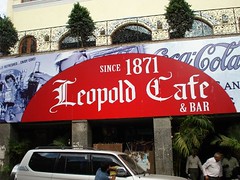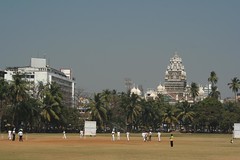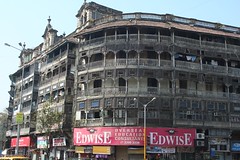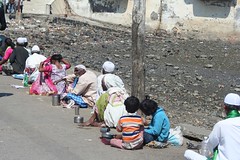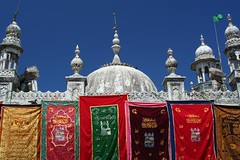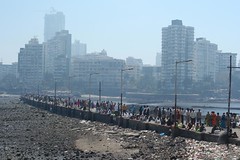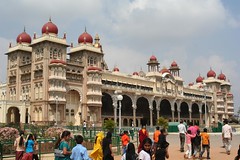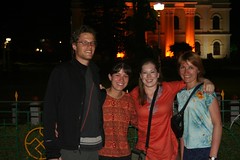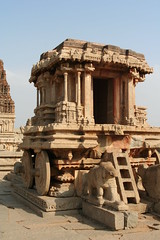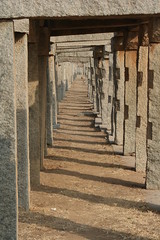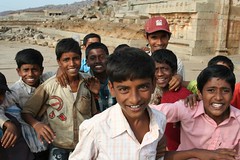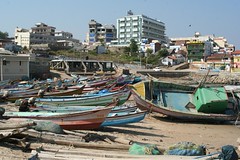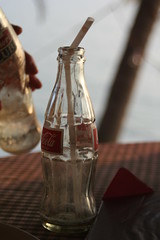
Click photo to see slideshow
or here for all Mumbai pictures
“Charras, mister? Some Hash?” a man shouts at me from the sidewalk. He’s busy relieving himself between two cars parked at the curb, but his head is turned to me. Obviously the bodily function he is attending to is not enough to prevent him from noticing western tourists crossing the neighborhood.
“No thanks,” I reply and I keep walking in the middle of the street; the sidewalk is too crowded. It’s getting dark and the street is busy with pestering hawkers, people cooking in their mobile kitchens, dirty kids dressed in tattered clothes, gawking tourists and Indian men sitting idle, grabbing their crotches.
“You look like you need some!” the pusher tries one more time, and goes back to his not-quite-so-private duty seeing that I ignore him.
I can’t leave my room at the Volga II hotel, right next door to Leopold’s Cafe, without being propositioned for hashish multiple times by the shady characters that hang around this major tourist spot in the heart of the Colaba district. Leopold’s is so popular with tourists that it draws crowds at the front doors, hopeful travelers clutching their Lonely Planet India bibles, waiting for a table to become free. The food is mediocre but the bar on the upper floor is nice. In “Shantaram”, the last novel I finished before arriving in Bombay, key parts of the action take place in this establishment, and many spirited, intelligent conversations unfold here during a round of drinks. My imagination has built up a different place; in it, Leopold’s was a large hall reached from the street by a short flight of stairs; there were dim lights hanging from low ceilings, a long brass bar counter in the back, massive wooden furniture and wall decorations and enough space for people to cruise between the tables without brushing against each other.
Of all Indian towns that I had already visited (and those that I would be visiting in the following weeks) Mumbai is the only one I liked. It is a place where you can even enjoy a walk through town; the filth is kept under control, the green areas are groomed and the sidewalks do not border on open sewers. Old tree-lined streets hide aging, moldy colonial mansions and boutique hotels; neighborhoods of high-rises and shopping malls stretch for miles in areas free of squatters and beggars; majestic, ornate Raj-era buildings like the Court of Justice, the CST railway station and the Prince of Wales museum define the centre and attract camera clicks; neat air-conditioned coffee-shops offer true divine espresso, wireless internet access and remind a bit of Starbucks; the maidans (centrally-located open, grassy areas where people play cricket or just hang out) are taken care of and occasionally re-planted with fresh grass.
Yet Bombay, if you look outside of the tourist areas, the old neighborhoods built by British or the flashy suburbs of the nouveau riche, has the same poverty like the rest of India and nowhere is it better seen than in the flood of beggars that line the causeway leading to the Haji Ali mosque – an icon of Bombay, located on a tiny piece of land that becomes an island at high tide. One side of the narrow concrete path is crammed with a motley assortment of humanity with missing body parts: maimed children looking sheepish, raising scrawny open hands in a plea for coins or pulling weakly at your clothes, as if to remind you of your feelings of western social guilt, groups of half-naked men exhibiting varied deformities, chanting a repetitive mantra to attract attention, old disfigured women covered in ragged dirty saris looking haggard, too exhausted to beg or move, decrepit elderly men collapsed on the pavement in the torrid sun, sleeping, or maybe dead – no one cares; if they’re still there at high-tide when the others have gone away, the sea will take care of their remains.
The other side of the five-hundred-yard-long causeway is the domain of the trinket sellers; here unthinkable loads of crap can be yours for a few rupees: key rings dangling small pink images of Ganesh the elephant god, plain brass or woven bangles, water pistols, decorated sea shells, combs, buttons and toothbrushes, electric toy-cars and crying Virgin Mary icons. The tiffin boys bring lunches to the peddlers (they must be making some money after all) winding their way through the crowd, balancing trays of five, six plates of rice and curry; yet I didn’t see any wealth resulting from the improbable sales being redistributed across the lane to the beggars who seemed to wait in vain for charity from visitors and pilgrims. But on our way back from the mosque we stumbled upon the most unexpected of sights - a man dressed in white pants and shirt walked the whole length of the causeway bowing in front of every beggar, putting a coin in their hands or dropping it in their tin cans. For a long time I followed this good Muslim giving his share of zakat to the poor of Mumbai until I lost sight of him. Once again it occurred to me that India is a land of unequalled contradictions, of cruel indifference and heartfelt compassion, the best and worst of everything.
Close to the Haji Ali causeway a few children were playing cricket on a concrete strip surrounded by fields of plastic garbage left behind by the low tide. From giant billboards advertising pale skin cream and glittering gold jewels, gorgeous young women were sending their frozen seductive smiles at the swarming, indifferent crowd. Distant skyscrapers shrouded in smog were flickering with Indian pride while a goat was rummaging unabashed through the mountains of refuse at my feet, in search for food. I looked back one last time toward the white, gleaming mosque and I made a place for this unforgettable city in my heart.
Posted from Railay, Thailand - gotta catch up fast!



